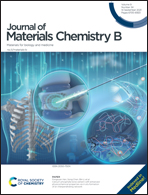Design of carboxylated single-walled carbon nanotubes as highly efficient inhibitors against Aβ40 fibrillation based on the HyBER mechanism†
Abstract
Misfolding and the subsequent self-assembly of amyloid-β protein (Aβ) is very important in the occurrence of Alzheimer's disease (AD). Thus, inhibition of Aβ aggregation is currently an effective method to alleviate and treat AD. Herein, a carboxylated single-walled carbon nanotube (SWCNT-COOH) was rationally designed based on the hydrophobic binding-electrostatic repulsion (HyBER) mechanism. The inhibitory effect of SWCNT-COOH on Aβ fibrillogenesis was first studied. Based on the results of thioflavin T fluorescence and atomic force microscopy imaging assays, it was shown that SWCNT-COOH can not only effectively inhibit Aβ aggregation, but also depolymerize the mature fibrils of Aβ. In addition, its inhibitory action will be affected by the content of carboxyl groups. Moreover, the influence of SWCNT-COOH on cytotoxicity induced by Aβ was investigated by the MTT method. It was found that SWCNT-COOH can produce an anti-Aβ neuroprotective effect in vitro. Molecular dynamics simulations showed that SWCNT-COOH significantly destroyed the overall and internal structural stability of an Aβ40 trimer. Moreover, SWCNT-COOH interacted strongly with the N-terminal region, turn region and C-terminal region of the Aβ40 trimer via hydrogen bonds, salt bridges and π–π interactions, which triggered a large structural disturbance of the Aβ40 trimer, reduced the β-sheet content of the Aβ40 trimer and led to more disorder in these regions. All the above data not only reveal the suppressive effect of SWCNT-COOH on Aβ aggregation, but also reveal its inhibitory mechanism, which provides a useful clue to exploit anti-Aβ drugs in the future.



 Please wait while we load your content...
Please wait while we load your content...